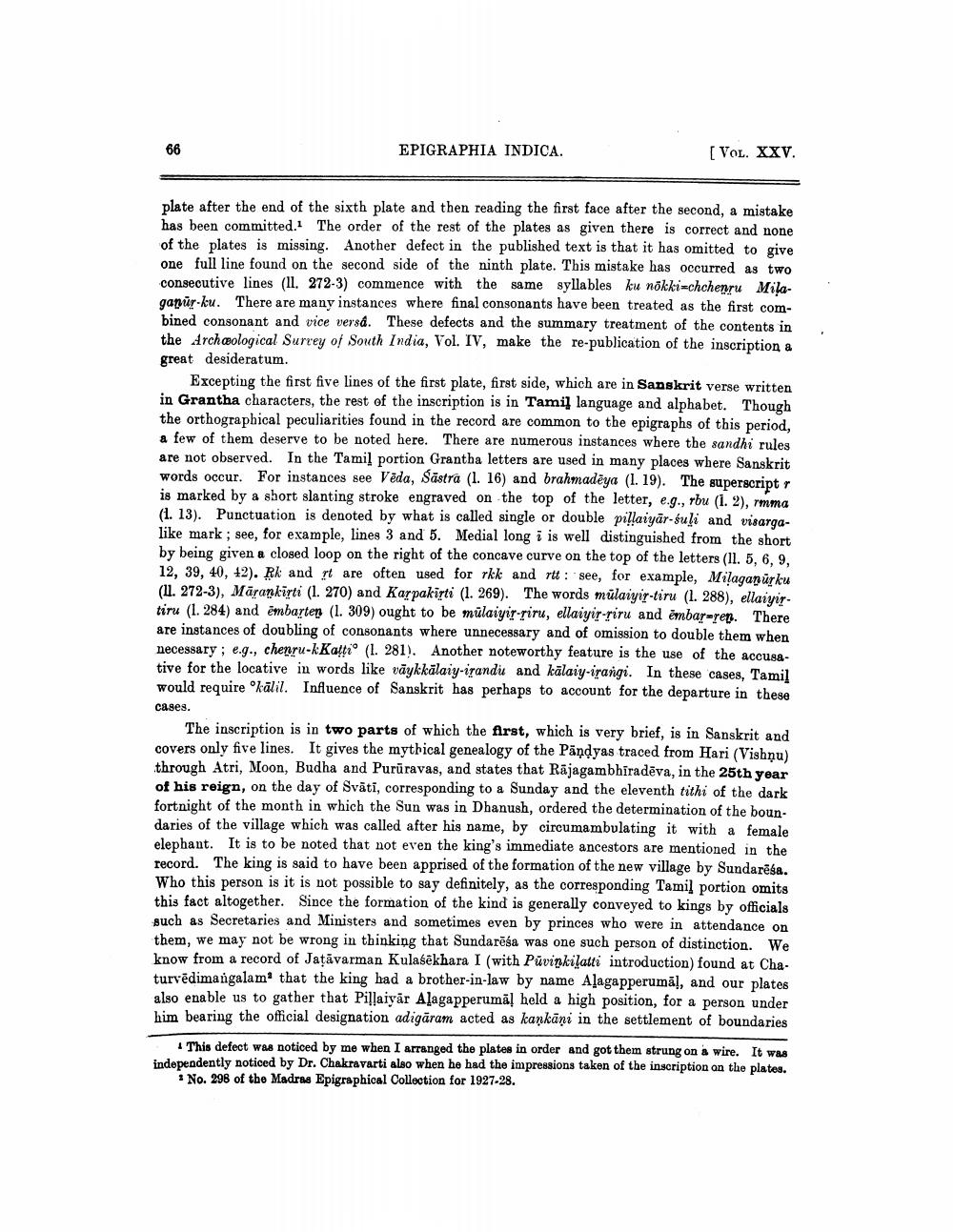________________
66
EPIGRAPHIA INDICA.
[VOL. XXV.
plate after the end of the sixth plate and then reading the first face after the second, a mistake has been committed. The order of the rest of the plates as given there is correct and none of the plates is missing. Another defect in the published text is that it has omitted to give one full line found on the second side of the ninth plate. This mistake has occurred as two consecutive lines (11. 272-3) commence with the same syllables ku nökki-chchenru Milagapur-ku. There are many instances where final consonants have been treated as the first combined consonant and vice versa. These defects and the summary treatment of the contents in the Archaeological Survey of South India, Vol. IV, make the re-publication of the inscription a great desideratum.
Excepting the first five lines of the first plate, first side, which are in Sanskrit verse written in Grantha characters, the rest of the inscription is in Tamil language and alphabet. Though the orthographical peculiarities found in the record are common to the epigraphs of this period, a few of them deserve to be noted here. There are numerous instances where the sandhi rules are not observed. In the Tamil portion Grantha letters are used in many places where Sanskrit words occur. For instances see Veda, Sastra (1. 16) and brahmadeya (1. 19). The superscript r is marked by a short slanting stroke engraved on the top of the letter, e.g., rbu (1. 2), rmma (1. 13). Punctuation is denoted by what is called single or double pillaiyar-suli and visargalike mark; see, for example, lines 3 and 5. Medial long i is well distinguished from the short by being given a closed loop on the right of the concave curve on the top of the letters (11. 5, 6, 9, 12, 39, 40, 42). Rk and rt are often used for rkk and rtt: see, for example, Milaganurku (11. 272-3), Marankirti (1. 270) and Karpakirti (1. 269). The words mulaiyir-tiru (1. 288), ellaiyirtiru (1. 284) and embarten (1. 309) ought to be mulaiyir-riru, ellaiyir-riru and embarren. There are instances of doubling of consonants where unnecessary and of omission to double them when necessary; e.g., chenru-kKatti (1. 281). Another noteworthy feature is the use of the accusative for the locative in words like väykkälaiy-irandu and kalaiy-irangi. In these cases, Tamil would require "kalil. Influence of Sanskrit has perhaps to account for the departure in these
cases.
The inscription is in two parts of which the first, which is very brief, is in Sanskrit and covers only five lines. It gives the mythical genealogy of the Pandyas traced from Hari (Vishnu) through Atri, Moon, Budha and Pururavas, and states that Rajagambhiradēva, in the 25th year of his reign, on the day of Svati, corresponding to a Sunday and the eleventh tithi of the dark fortnight of the month in which the Sun was in Dhanush, ordered the determination of the boundaries of the village which was called after his name, by circumambulating it with a female elephant. It is to be noted that not even the king's immediate ancestors are mentioned in the record. The king is said to have been apprised of the formation of the new village by Sundaresa. Who this person is it is not possible to say definitely, as the corresponding Tamil portion omits this fact altogether. Since the formation of the kind is generally conveyed to kings by officials such as Secretaries and Ministers and sometimes even by princes who were in attendance on them, we may not be wrong in thinking that Sundaresa was one such person of distinction. We know from a record of Jațavarman Kulasekhara I (with Püvinkilatti introduction) found at Chaturvēdimangalam that the king had a brother-in-law by name Alagapperumal, and our plates also enable us to gather that Pillaiyar Alagapperumal held a high position, for a person under him bearing the official designation adigaram acted as kankani in the settlement of boundaries
This defect was noticed by me when I arranged the plates in order and got them strung on a wire. It was independently noticed by Dr. Chakravarti also when he had the impressions taken of the inscription on the plates. No. 298 of the Madras Epigraphical Collection for 1927-28.




